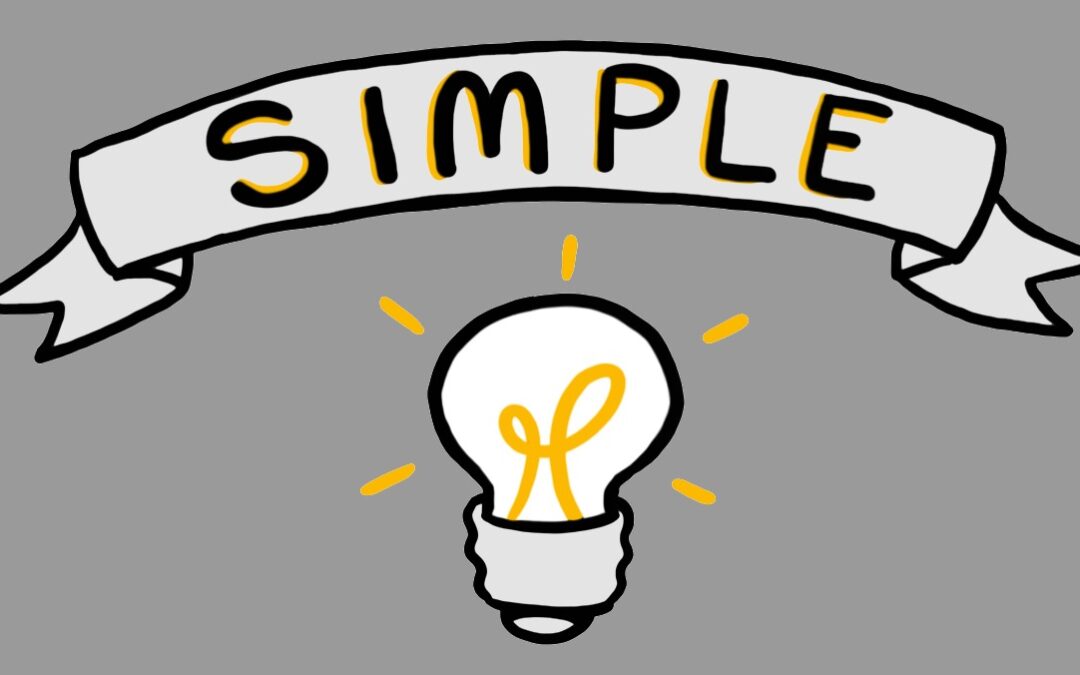It’s easy to find numbers that prove the value of simplicity in marketing. 61% of consumers are more likely to recommend a brand because it offers them simpler experiences and communications. 64% are willing to pay more for those simpler experiences. Brands that simplify decision-making for customers are 115% more likely to be recommended, and 86% more likely to be purchased.
Those figures might have already convinced you, and if so: perfect. It doesn’t get much simpler than one paragraph, one source, and one point—so if you’re ready, go forth and simplify!
I hope you didn’t actually just go forth, because I’ve got a few more thoughts (that I’ll try to keep simple, of course). While figures are great for establishing the value of simplicity, let’s take a little time on the rationale behind it.
A Simple World
Sairam Krishnan quotes Johnjoe McFadden’s essay “Why Simplicity Works” on one of simplicity’s biggest strengths: it’s the nature, and goal, of science. “Many advances of modern science involved a succession of simplifications… probably the greatest simplification was provided by Newton, who unified trillions of motions, both on Earth and in the heavens, into just three laws of motion and one of gravity.”
In other words, there’s a reason that free-associating from the word ‘nature’ tends to produce responses like ‘simple,’ ‘pure’ and the like. It’s not just a feeling many of us share—it’s an accurate collective observation. And in marketing, the natural and easily agreed-upon is always safer than the alternative.
Helping People Understand, Fast
Krishnan, writing for the SaaS market, follows McFadden’s advice on simplicity by boiling down all SaaS marketing to two endeavors: demand capture (clear differentiation and visibility, secured through SEO, Google ads and content marketing) and demand creation (opinion and taste-making, via podcasts or other media brand exposure tactics).
Regardless of your industry, though, simplicity in marketing performs a crucial service: it ensures comprehension. “People understand simple. The more complex the wording, the more misunderstanding (and non-understanding) there will be,” and the last thing you want is confusion when trying to generate interest in your offerings.
Besides clarity, simplicity also imparts brevity—a serious advantage in a world of dwindling attention spans. Complexity, broken down, is just an overlong list of simple ideas. Think of how long it would take you to explain how an automobile functions. Now, think of how you’d describe the steering wheel, by itself. “If it’s a simple message, it might not take long to deliver.”
An Important Distinction
Short, simple messages are quick to deliver, and more easily understood by listeners. Yet, communications driven by simplicity actually have more than one definition, Dianna Booher argues: communicating simply, and communicating simplicity.
“Communicating simply enables people to read,” Booher contends. “Communicating simplicity helps people to decide, buy, work.” She then lays out the barriers to understanding:
- Too many ideas detract focus from the primary goal
- Too many ideas clash. Mixed messages bewilder people.
- Irrelevant details bury key ideas and dilute emphasis.
- Complex, disorganized documents discourage people from digging further to decide and to execute plans.
- Convoluted statements that require “processing” and “clarifying” waste time.
“It’s all just too much white noise,” Booher announces, shortly before concluding that “Simplicity sells. Complexity stalls.” It certainly seems like her diagnosis of the problems of understanding dovetails with what we’ve encountered before: too many elements make a thing complex, especially when those elements conflict with one another or add nothing to the overall message. Moreover, it’s important to be organized enough that your audience sees the next steps clearly and takes them easily.
Unfortunately, we only receive one tip for communicating simplicity: it “involves an entirely different intention and thought process.” Compared to her example of communicating simply—“See Jane run”—it makes sense that communicating simplicity is probably even more useful, but couldn’t the two be combined?
When speaking about simplicity, why not also speak simply?
We Live and Breathe Simplicity
At TruScribe, communicating simplicity in a simple manner is our mission with nearly every project. No matter how seemingly complex the topic of a client’s script, our artists masterfully distill the core concepts and focus on them above all else. They’re masterful simplifiers, and adept at finding where and how the topic promotes a simplified experience for the viewer.
They then visualize that message with drawings that are just right for the subject matter. While our artists don’t create cartoonish, juvenile images, they also avoid highly ornamented, overly intricate drawings. The choice to avoid the latter is two-fold: one, simplicity is easily understood in comparison to highly complex visuals, and two, simple images transmit the message without distracting from it.
That’s why, even if your script is about the Sagrada Familia Cathedral, TruScribe’s representation will be not a one-to-one perfect replication of the building. Research has taught us that when such an intricate representation is onscreen, the viewer is transfixed, and not paying attention to anything else. This means not listening to the voiced script, and missing all of the carefully written messaging for the scene.
Finally, Booher sums up simplicity’s persuasive power with four bullets:
- Simplicity allows us to grasp the whole concept quickly and easily.
- Simplicity leads to understanding.
- Understanding aids recall.
- Recall builds momentum for action.
We couldn’t have said it better ourselves. Simplicity helps us ensure that our clients’ messaging is clear, easily understood, and quick to drive action.

